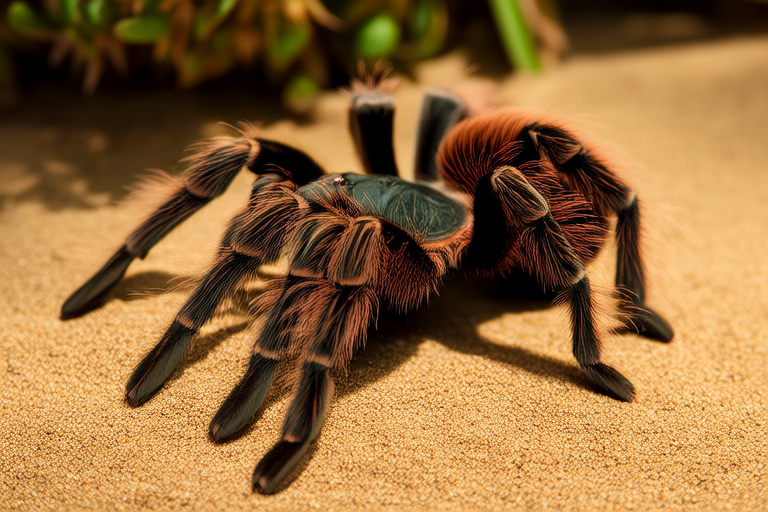Tarantulas: The Low-Maintenance, High-Coolness Factor Pets of 2023
In recent years, tarantulas have emerged as a unique and intriguing choice for pet enthusiasts seeking a low-maintenance companion that adds a touch of exoticism to their homes. These eight-legged wonders, often shrouded in mystery, are rapidly gaining popularity for their minimal care requirements and high coolness factor. With a variety of species to choose from, each offering its own set of characteristics, tarantulas can be a perfect addition for those looking for a pet that stands out from the crowd.
The Habitat Needs of Tarantulas
One of the primary reasons tarantulas are considered low-maintenance pets is their relatively simple habitat requirements. Unlike many other pets, tarantulas do not require elaborate setups or frequent changes to their environment. A well-ventilated enclosure, such as a glass tank or plastic terrarium, is sufficient to provide them with a comfortable living space. The enclosure should be spacious enough to allow the tarantula to move freely and should include hiding spots, such as cork bark or half logs, to mimic their natural environment. Substrate, like coconut fiber or soil, should be provided for burrowing and humidity regulation. Maintaining a temperature range between 75°F and 85°F (24°C to 29°C) and a humidity level around 60% ensures optimal conditions for most tarantula species.
Diet and Feeding
Feeding tarantulas is straightforward and requires minimal effort. Insects such as crickets, mealworms, and dubia roaches are ideal food sources. The size of the prey should be appropriate for the tarantula’s size, typically no larger than half the width of the spider’s body. Feedings can be done once or twice a week, depending on the species and age of the tarantula. It’s important to provide fresh water in a shallow dish, which should be cleaned and refilled regularly to prevent bacterial growth. Some species may also drink droplets of water sprayed onto the enclosure walls.
Differences from Common Pets
Compared to more traditional pets like dogs or cats, tarantulas offer a distinct experience. They do not require daily walks, grooming, or social interaction, making them ideal for busy individuals or those who prefer a hands-off approach to pet care. While they are solitary creatures, tarantulas can be fascinating to observe. Their slow movements and unique behaviors, such as molting and web-building, provide endless opportunities for engagement without the need for direct interaction. This makes them particularly appealing to people interested in nature but who may not have the time or inclination for more demanding pets.
Choosing the Right Species
With over 1,000 species of tarantulas worldwide, selecting the right one for your lifestyle is crucial. For beginners, it’s recommended to start with species known for their docile temperaments and lower care requirements. The Chilean Rose Hair Tarantula (Grammostola rosea) is a popular choice due to its calm demeanor and ease of care. Other suitable options include the Mexican Red Knee Tarantula (Buthus mexicanus) and the Guyana Black Tarantula (Aphonopelma seemanni).
For more experienced keepers, species like the Goliath Birdeater (Theraphosa blondi) or the Brazilian Salmon Pink Birdeater (Pterinochilus murinus) can be considered. These spiders are known for their impressive size and striking appearance but require more advanced care, including larger enclosures and specialized feeding techniques.
Benefits of Owning a Tarantula
Owning a tarantula offers numerous benefits, primarily centered around their low-maintenance nature. They do not demand constant attention or extensive care routines, allowing owners to enjoy their company without the stress of daily responsibilities. Additionally, tarantulas add an element of intrigue and fascination to any home. Their exotic appearance and unique behaviors can captivate both children and adults alike, sparking curiosity and interest in the natural world.
Moreover, tarantulas can serve as excellent educational tools, teaching responsibility, patience, and respect for wildlife. They provide a peaceful and serene presence, contributing to a calming atmosphere in the home.
Addressing Misconceptions
Despite their growing popularity, many misconceptions surround tarantulas. One common myth is that all tarantulas are aggressive and dangerous. In reality, most species are quite docile and will only bite if threatened. Another misconception is that tarantulas require extensive care and attention, which is far from true. Their minimal maintenance and self-sufficient nature make them ideal pets for individuals with busy lifestyles.
It’s also important to dispel the notion that tarantulas are unsuitable for children. While direct handling is generally discouraged, observing tarantulas can be a safe and educational activity for children when supervised by a responsible adult. This can foster a sense of wonder and appreciation for the natural world.
Responsible Ownership and Further Learning
Before bringing a tarantula into your home, it’s essential to research and understand the specific needs of the species you’re considering. Responsible ownership involves providing a suitable habitat, a balanced diet, and regular health checks. It’s also crucial to consider the lifespan of tarantulas, which can vary widely depending on the species, ranging from 10 to 30 years or more.
To deepen your knowledge and ensure responsible ownership, consult reputable books, attend workshops, or join online forums dedicated to tarantula keeping. These resources can provide valuable insights into the care, behavior, and breeding of tarantulas. Additionally, local herpetological societies or reptile expos can offer opportunities to meet experienced keepers and learn from their firsthand experiences.
As we conclude our exploration of tarantulas, it’s clear that these fascinating creatures offer a unique and rewarding pet experience. With their minimal care requirements and intriguing personalities, tarantulas are poised to become even more popular in the coming years. Whether you’re a seasoned enthusiast or a curious beginner, there’s no denying the charm and allure of these remarkable arachnids. Embrace the opportunity to bring a piece of the wild into your home and discover the joy of tarantula ownership.
